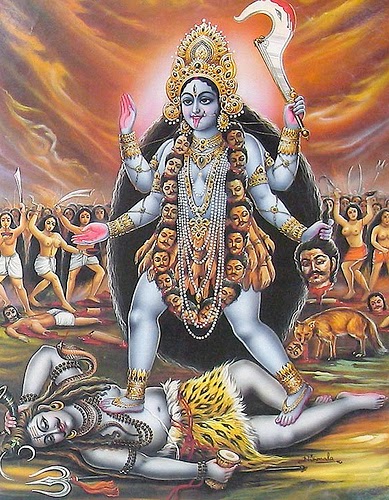Goddess Kali: Symbol of Destruction

Goddess Kali is the ultimate representation of the feminine power of destruction. The way she is portrayed in Hindu mythology is nothing short of eye-catching. She is unabashed and untamed, with her heart and mind set upon destructive endeavours. Born out of the brows of Goddess Durga during one of her fights with demons is the reason why Kali is black in colour.
She is seen with her hair untied, one of her four hands clutching a demon’s severed head and another holding the kharga or curved sword. Her two other hands are dedicated to her devotees, promising protection and blessings. She wears a garland of severed demon heads and a girdle of severed demon hands.
Why Goddess Kali stepped on Lord Shiva?

But if she is benign in the slightest sense, then why does Goddess Kali stand on Lord Shiva with her tongue sticking out?
Once, the Goddess allowed herself to get loose upon creation, and go on a raging rampage. No demon, human or God stood a chance at stopping her lust for bloodbath. Then, a collective prayer was sent to Lord Shiva to try and stop this Maha-Shakti form of his consort. Such was the power of the Goddess that wherever she set foot, absolute destruction followed suit. Lord Shiva then realised even he could not reason with such an elemental force. He had to reach out to her in terms of emotions. As such, he decided to lay down in the Goddess’ path. When Goddess Kali finally reached the spot where Lord Shiva was lying down, she did not notice him until she stepped on his chest. So far, everything she had set her foot upon, had been destroyed beyond recognition. But this time was an exception. Kali was forced to look down and see Shiva. Indeed, it was a very unusual situation because of their mutual relationship.
Sudden realization dawned on her and she snapped out of her reverie and found herself extremely ashamed, and stuck out her tongue instinctively as a sign of regret. The ability to realize propriety and adhere to sense even as she was drunk with the passion for destruction, proves the Goddess’s ability for compassion.
Artists and sculptors choose to depict this statue of the Goddess, in order to capture the perfect balance of passion and humility. Alongside unbridled power, exists frank sense of accepting her mistake.
Goddess Kali represents the ultimate devourer. She is seen bathed in blood, with one of her legs folded upon her knee. The figure she represents is one that is sufficient to strike fear into the weak-hearted. It is no surprise, therefore, that early oriental historians assumed that Goddess Kali herself was a demon. Blood sacrifices of animals are not uncommon in Kali worship. She is being worshipped in demon style.
In certain places where dacoits worshipped the Goddess, she is known to have received human sacrifices too. Even Lord Shiva’s Tandav Nritya seems somewhat tame next to Kali’s dance of destruction.
Kali’s tongue sticking out has a dual meaning. In the first instance, it underscores her insatiable, omnivorous appetite for all the tastes that this world of senses has to offer.
A Kali without her tongue protruding is called Bhadra-Kali or the benign face of Kali, who possesses all feminine graces. When she resides in household shrines in this form, she serves as the guardian of the family.
We learn from Goddess Kali’s example that even righteous anger, bore out of the desire to protect one’s devotees as a mother would protect her children, can turn into a blood lust. That kind of anger is. at times, necessary to singe off all signs of bondage and evils of dependence on material ties.
Goddess Kali is mostly referred to as “Maa” – a popular address directed to mothers. The worship of Goddess Kali, therefore, stands for the devotees’ desire to find the primal protection of the mother, to guard against material and spiritual evil.



